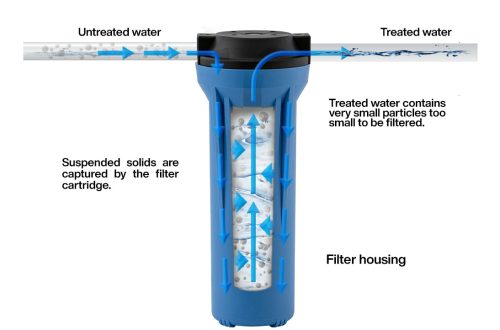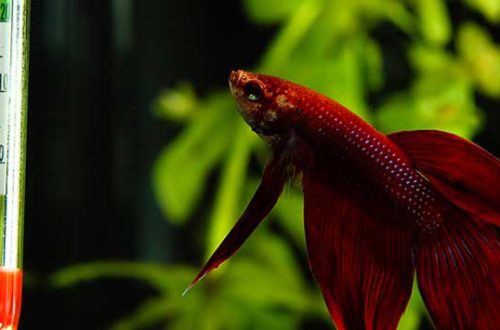
Sterba corridor: keeping and breeding, the difference between a male and a female, types and other nuances
A beautiful, well-groomed aquarium will become a real decoration of any room. To make it unusual will help a small representative of the genus of corridors – the corridor of the shterba. Unpretentious in content, the fish will delight the owners for several years.
Contents
Types of corridors and their description
Adults reach a length of 6-6,5 cm. If you want to buy a similar fish for your aquarium, then preference should be given to young animals, whose size is about 3 cm.
It is difficult to confuse the Sterba corridor with another type of catfish, because it has a rather original color. Its body is black or dark gray dotted with white dots, most of which are located near the caudal fin. Around the rest of the fins there is an orange narrow line that gives the fish a more unusual look.
Sometimes you can find a unique variety of this type of corridor – albino. It differs from ordinary fish in the complete absence of pigmentation. His entire body, including his eyes, is white.
About 180 species of corridors have been recorded in nature. Consider the most popular species purchased by people for aquariums:
Mottled. It is distinguished from others by a gray-olive color with numerous dark spots and a high fin on its back. The maximum body length is 8 cm.

Speckled Corydoras – the most popular catfish of this species
Meta. Characterized by yellow color. In this case, the fin on the back is always black and blue. Body length does not exceed 5 cm.
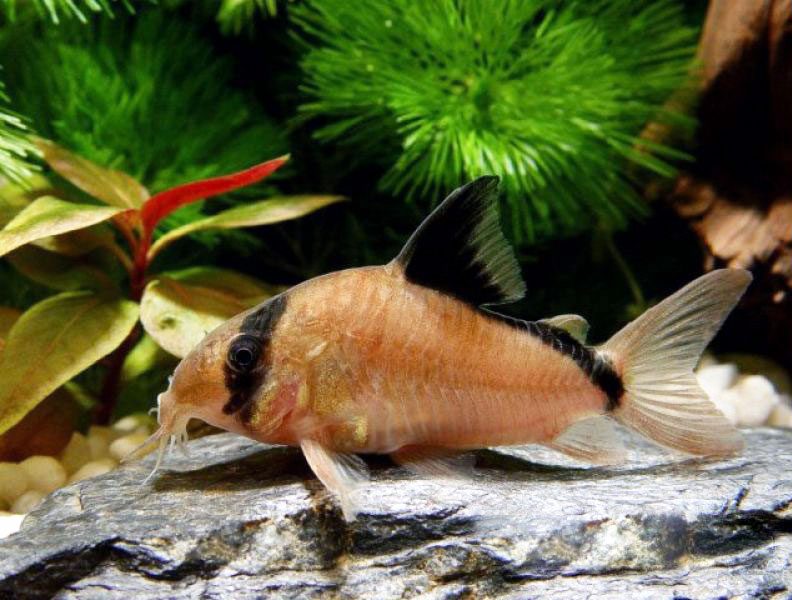
Corydoras meta prefers light ground because it is perfect for camouflage.
Golden. It got its name from the thin gold stripe on the back. The maximum size of an adult is 7 cm.
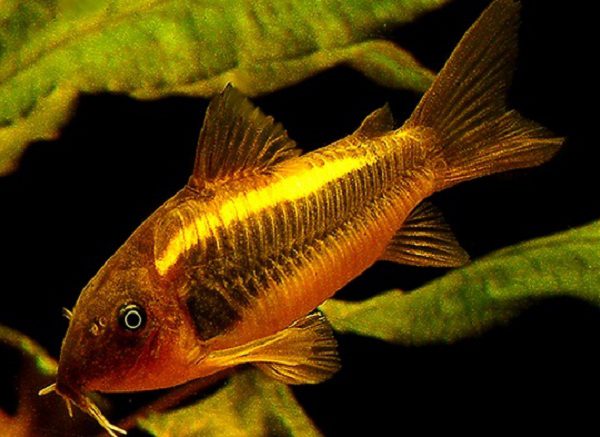
Golden corridors are sometimes called bronze catfish
Corydoras panda. The body has a white or white-pink color, and the area of the eyes and caudal fin resembles black spots. These are one of the smallest representatives of the species, their size does not exceed 3-4 cm.
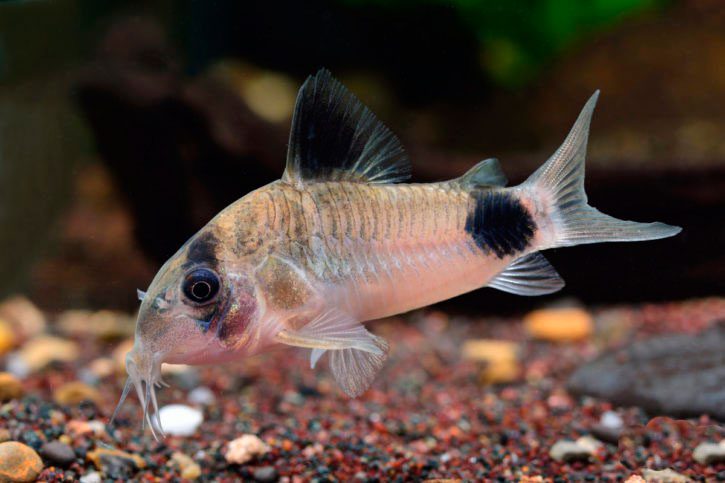
The panda corridor with its dark spots resembles a Chinese bear, which is why it got its name
Nanus. It comes in different shades: yellow, light brown and silver. Body length – 6–6,5 cm.
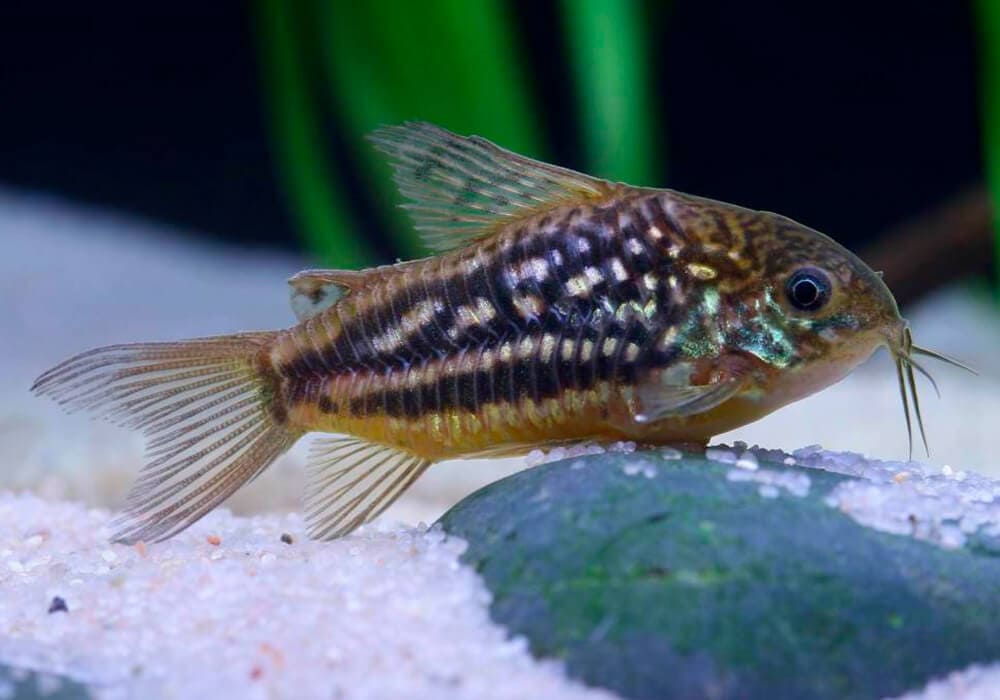
This coloration helps nanus to hide from predators against a dark background of the bottom.
Adolf’s corridor. Her white body in adulthood reaches only 5 cm. The peculiarity of this fish is that there is a bright orange spot and black stripes on the back. There is a black border around the eyes.
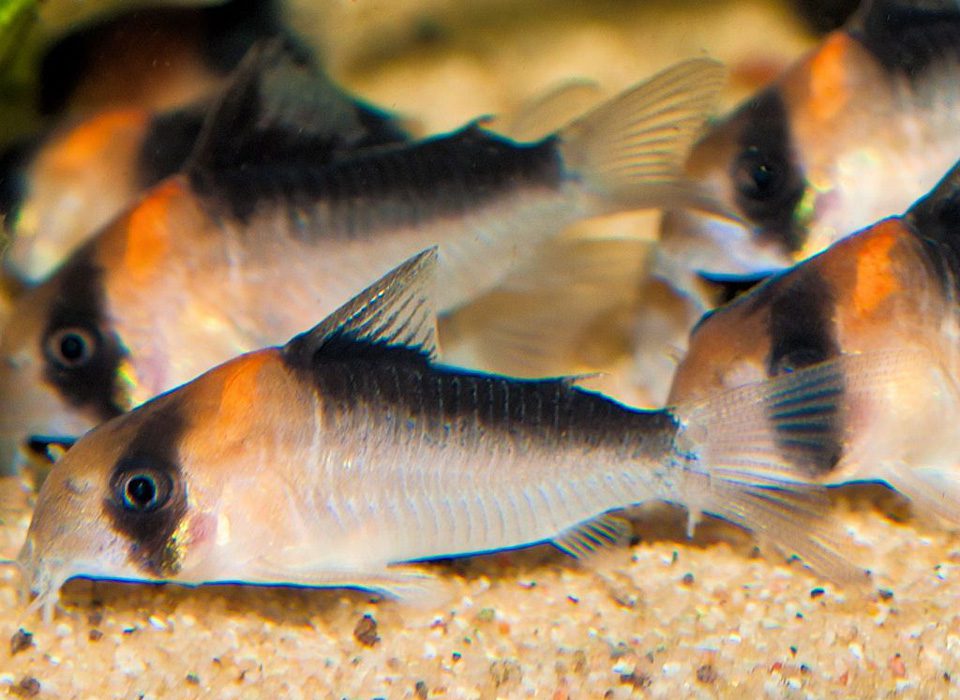
Somik got its name in honor of Adolf Schwarz, a Brazilian exporter
Leopard. It differs from other representatives in an unusual appearance, very similar to a leopard. Body length 5–6 cm.

Another name for leopard corridors is three-line
Arcuatus. It eats only ground food and is considered a cleaner of artificial reservoirs. The size of the fish is within 5 cm. The body is beige with a black stripe in the middle.
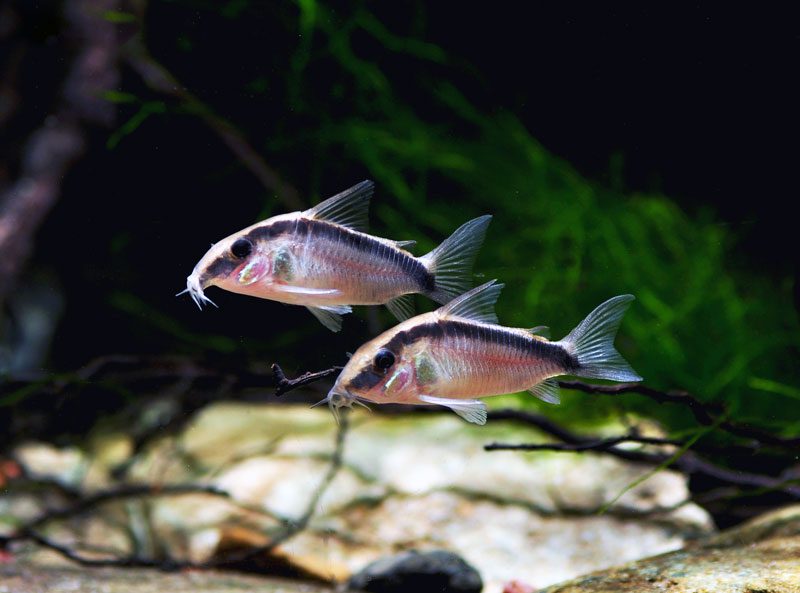
Corydoras Arcuatus may also have a golden hue
Habrozous. The fish can be of different colors: beige, green, yellow-beige. The pattern on the body consists of several dark stripes, the clearest is in the middle of the body. Its size does not exceed 2,5 cm.

Corydoras Habrosus – one of the three species of pygmy catfish
Features of behavior
Immediately after settling in the aquarium, the fish can behave restlessly, swim quickly and often rise to the surface of the water. This is normal behavior, indicating that the catfish has not yet got used to the new place of residence. Over time, he will calm down and show his peaceful nature. When the catfish is happy with everything, it most often lies at the bottom or hides somewhere in the algae. So he is resting, so you should not worry about such behavior.
Pros and cons of Sterba corridors
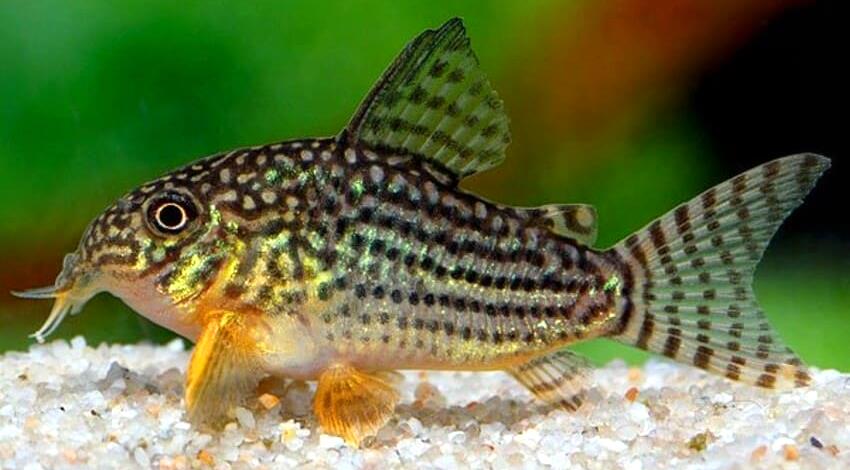
Shterba corridor is a calm and schooling fish, which is enough for several relatives and a spacious bottom
Before you settle these catfish in your aquarium, it is better to familiarize yourself with their advantages and disadvantages in advance. Among the positive properties are:
- Unpretentiousness in food.
- Peaceful character.
- Nice appearance.
- Easy breeding at home.
Disadvantages:
- It is necessary to ensure that the water is always clean, otherwise the fish may die.
- Mandatory water changes should occur at least once a week.
Care and maintenance
When planning to have Sterba corridors in your artificial reservoir, you need to know about the basic rules for their maintenance.
What to feed
Catfish are picky when it comes to food. They eat any artificial food. Most often they are collected from the bottom and very rarely picked up when the food falls. Occasionally, you can pamper the fish with frozen and live food, in this case preference should be given to the tubifex, so as not to cause disruption of its gastrointestinal tract.
If there are many other inhabitants in the aquarium, make sure that the corridor gets enough food. This will be done by special sinking food designed for fish that collect food from the bottom of the reservoir. Experts advise feeding in the evening with the lights off.
It will be possible to grow healthy fish if you feed the fry with infusoria and microfeed. When they begin to grow a little, add well-washed young brine shrimp to the diet.
Diseases and treatment
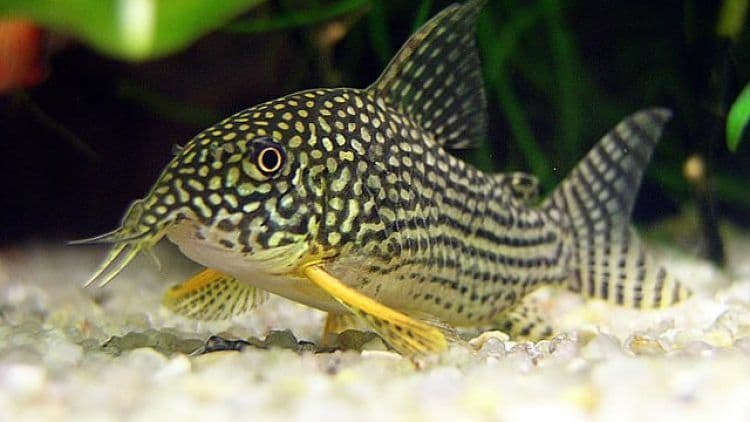
Before you start treating a fish, you need to make sure that it is really sick.
It is better to quarantine a newly acquired corridor fish in a separate container for several days.
If the fish has rapid breathing, and it often floats on the surface of the water, nitrogen poisoning may be the cause. When spots or growths appear on the body, it can be argued that there are fungal formations in the water that got into it along with the food. The cause of this phenomenon may be external parasites.
It is necessary to treat the fish immediately with special preparations. If you don’t know what to buy, ask your veterinarian for help.
The necessary conditions
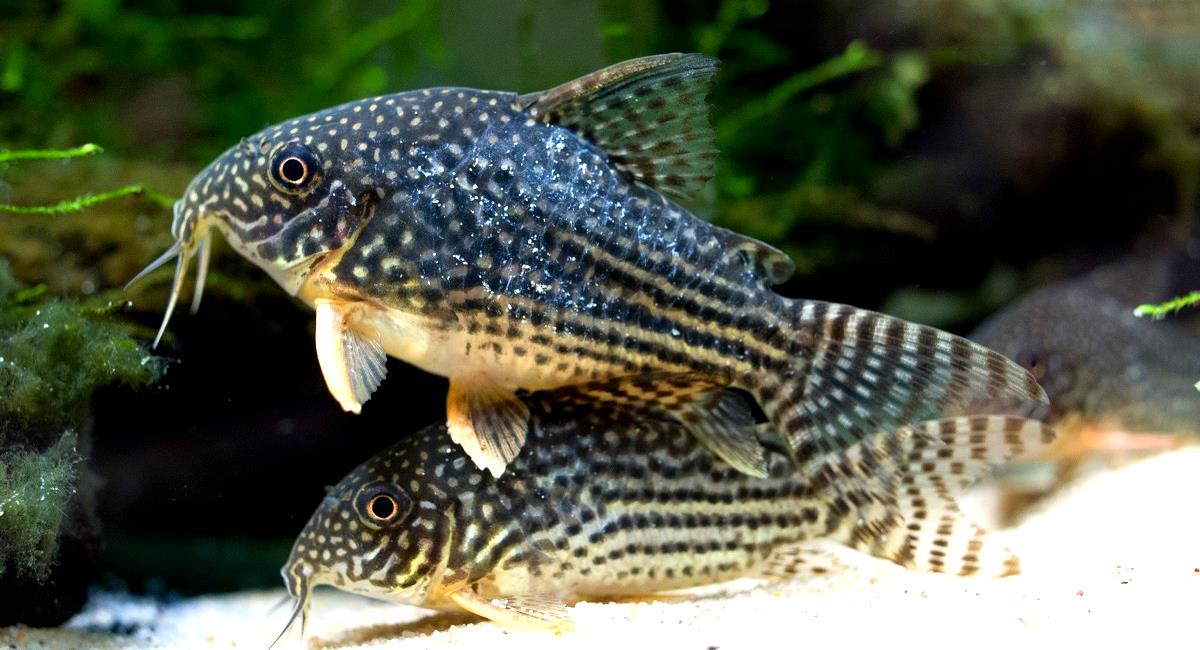
Decorations in the aquarium – a prerequisite for corridors
In order for the fish to feel good in your aquarium, you need to create high-quality conditions for its life.
Here are the main content rules:
- Catfish cannot live alone, so you need to buy him a company of 5–10 fish of his species.
- Since the fish prefers to spend most of its time near the bottom, settle it in a low, wide, elongated artificial reservoir with a large bottom area.
- A flock of 5 fish must live in a tank with a volume of at least 50 liters.
- Acceptable water temperature cannot fall below 24 degrees and rise above 28 degrees.
- Be careful not to get salt in the water.
- The fish does not tolerate the presence of chemicals and medicines and copper in the water.
- Every week you need to change the water in the aquarium.
- The presence of a high-quality filter is one of the main conditions for keeping fish in a glass tank. In its absence, the liquid will be dirty and cloudy, because the catfish constantly stir up the soil.
- Install a compressor to provide the correct amount of oxygen.
- If the aquarium has a lid or glass, do not fill the water up to the top level. Fish sometimes swim to the surface.
- The roots of algae will have to be pressed down with stones so that the catfish do not tear them out.
- It is better if the soil is sandy, made of pebbles or gravel without sharp edges, because catfish can injure their antennae about them.
- Choose diffused light.
- The fish cannot always be in sight. That is why it is necessary to put a castle in the aquarium, a broken jug, a piece of pipe or some other decorative element in which one could hide.
If you notice that the catfish tries to spend as much time as possible on the surface of the water and at the same time breathes often, it means that he does not like something in the aquarium.
Who do they get along with in the aquarium
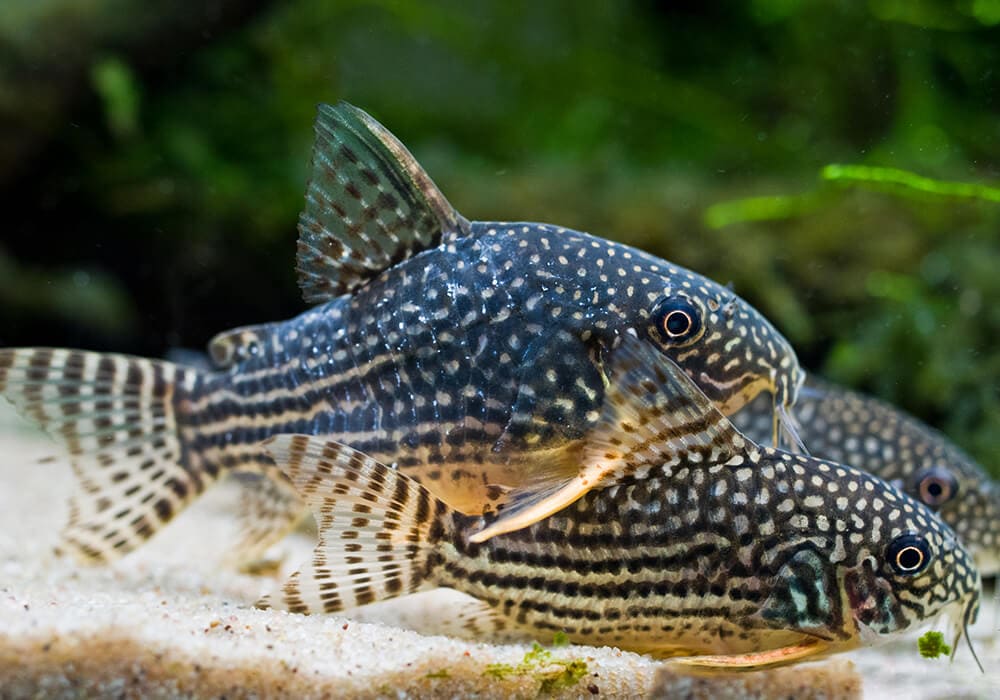
Sterba corridor can get along with many other fish, the main thing is that there is always enough space for them at the bottom
Best of all, corridors live with representatives of their own species. That is why experts advise purchasing a group of 3 soms or more. Among other varieties of fish, preference should be given to labyrinth, haracin, carp, viviparous and other peaceful catfish.
Corydoras do not get along well with large fish characterized by aggressive behavior, as well as catfish that like to protect their personal territory.
Breeding Sterba corridors at home
Breeding corridors is quite simple, it is important to take into account all the nuances in advance and prepare the necessary conditions.
The difference between a female and a male
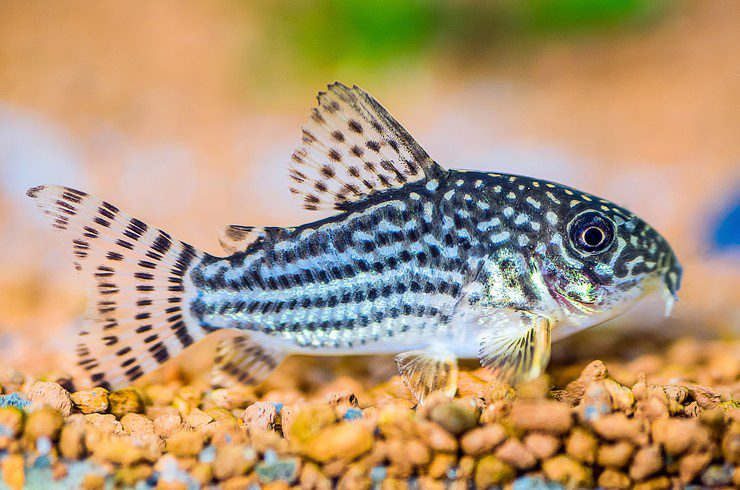
Like all catfish, the female of the Sterba corridor is larger and rounder than the male.
Determining the sex of a fish is easy. Males are smaller than females, and their belly is not as thick. This is best seen when looking at the fish from above.
Reproduction and spawning
To start stimulating spawning, perform a number of the following actions:
- Fish are fed live food in large quantities.
- Almost every day, water changes are carried out (for this, it is enough to pour about half of the clean liquid into the tank).
- It is also recommended to reduce the water temperature by 2-3 degrees.
In order for spawning to proceed correctly, you need to think in advance about creating a high-quality spawning ground. In the event that there will be from 2 to 4 fish in it, the aquarium should be filled with 15–20 liters of clean water. At the bottom of such a tank, Javanese moss is laid, as well as several plants with large leaves. Make sure you have a compressor. The filter must have a sponge so that the fry that have just appeared are not sucked into it.
When the females are very round from a large amount of caviar, they are planted with the males in the evening in the spawning ground. There should be about two or three males per female. The spawning process begins, as a rule, in the morning of the next day. If nothing happened before lunch, then you need to change the water a few more times.
On a well-cleaned place (glass, plant leaves), the female sticks eggs. Depending on the size of the female and her age, the minimum number of eggs is 30 pieces, and the maximum is 1000, the size of one is 2 mm.
When spawning is completely over, all catfish are sent to a common aquarium so that they do not eat caviar. Be sure to ensure that among healthy eggs there are no affected by the fungus, the infected must be removed.
In the spawning room, the water temperature is increased to 26 degrees and maintained until the fry appear. This sometimes takes 4-7 days. After two days, you can start feeding them.
How many live in an aquarium
In natural reservoirs, the life expectancy of corridors is a maximum of 8 years. In the aquarium, this figure does not exceed 3-4 years.
Sterba Corydoras is an amazingly beautiful fish that is easy to breed at home. Despite the fact that there are still few of them in our country, every year they are becoming more and more popular. Having such fish in your aquarium, make sure that all the conditions for their comfortable life are met, and then they will delight you and your loved ones.



